State School for the Blind, Raleigh, N.C.
Flashback Friday visits the old State School for the Blind this week. Few readers are probably aware that its campus once occupied a verdant Caswell Square, which nowadays is encircled with busy traffic and crowded with state government office buildings.
No message on this well-preserved card, which is more than 100 years old.
Our beautifully color-tinted postcard this week was printed by the Leighton & Valentine Co., based in New York City.
As was common in those days, a local publisher would send a photograph of a particular landmark to the postcard printer who would use the image as the basis for the final product. In this case, the photo seen below was used. It was reproduced as a halftone, touched up with color tinting, with details such as the leaves on the trees, the pedestrians and carriage on the street being added. If you compare the postcard with the photograph original you’ll see that the overhead street light and the two telephone poles were airbrushed out, leaving behind one as but a stump!
This photo was taken around 1912 and was used in a program booklet published in 1915 for the 70th anniversary of the establishment of the State School for the Blind and Deaf*.Â
Another image from the same 70th anniversary publication shows the campus as it appeared in 1896.
In 1927 the School for the Blind, now known as the Governor Morehead School, relocated to a sprawling 75-acre site on Ashe Avenue. Subsequently, most of the old buildings on Caswell Square were razed, and the state filled the square with government office buildings over the course of the next 25 years.
The postcard seen below depicts the boys dormitory which was added to the Blind School campus on Caswell Square in 1898. This card dates to around 1910 and was printed as a collotype rather than halftone. (A collotype is a continuous tone image printed from a glass plate.)
The boys dormitory is the only structure remaining on Caswell Square from the original campus of the State School for the Blind.
After decades of benign neglect, the former boys dormitory was restored to near its original appearance by the state about ten years ago. Although it is surrounded by 20th century government office buildings, the old ‘castle’ still commands a regal presence at the corner of Jones and Dawson Streets.
*Seventieth Anniversary Exercises of the State School for the Blind and the Deaf was published in 1915. A copy may be found in the State Library of North Carolina. You may also read it online.
Our Flashback Friday postcards this week were printed by Leighton & Valentine, and American News Co. of New York, NY.
Leighton & Valentine  1910-1914
New York, NYFormed by the merger of the Hugh C. Leighton Company with Valentine & Sons, and Sackett & Wilhelms. Their cards were printed in the tinted halftone style of Valentine & Sons. Some of their white border cards were printed in continuous tone lithography. All these cards were printed in the United States.
American News Co. Â 1864-1957
119 Nassau Street, New York, NYFounded in 1864, this firm became a major distributor of books, magazines, newspapers, comic books and postcards exclusively through their national network of more than 300 affiliated news agencies. Most of their cards were printed in Leipzig, Dresden and Berlin, but they switched to American and French printers during WW I. Their closure in 1957 led to great difficulties in distribution, putting many small publishers out of business as well.
Excelsior — A German made card printed in collotype. It was the first series this firm printed and later marketed as their highest quality black and white card (most customers chose this type over their cheaper halftone cards). Almost all cards in this series are printed in black and white, but there are some later examples issued in monochromes of blue, green, and sepia as well as rare cards that were printed in color and hand colored.
Prefix A 1-4999 beginning in 1906
Prefix B 1-4999 beginning in 1908
Prefix D beginning in 1910
Prefix F 1-8000 beginning in 1912
Prefix AA for Blue, Green, Sepia & Hand colored cards (1908-1925).
“Flashback Friday†is a weekly feature of Goodnight, Raleigh! in which we showcase vintage postcards depicting our historic capital city. We hope you enjoy this week end treat!
Â

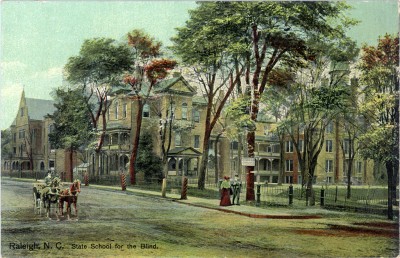

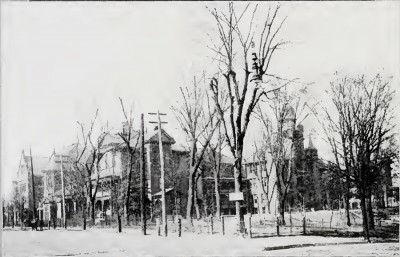
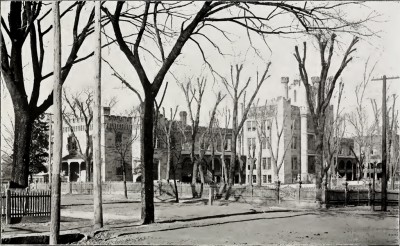
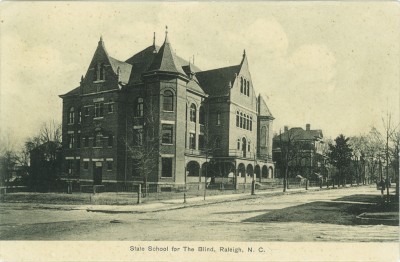
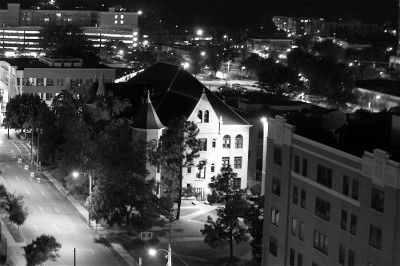
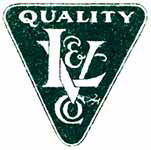
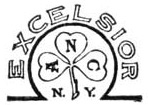
 Sign up for the Newsletter
Sign up for the Newsletter
03/18/2014
The broom and mattress shops were located in a gray brick building that still sits behind the “castle.”
03/18/2014
The remaining building is lovely but the original open square would be so much lovelier!! Thanks for the trip down memory lane.
03/29/2014
Thanks, NCSU– I’ve always wondered what that grand building was back there. It’s been empty and dilapidated as far back as my memory goes! I’d love to see a picture of it in its heyday.